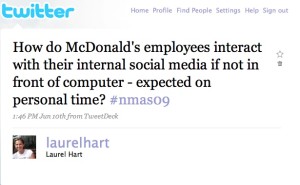Bias and Social Media
Do you ever have one of those “A-ha!” moments when you find some piece of information that’s the missing piece of the puzzle to some problem you’ve been stewing over?
In mid-June I attended the 2009 New Media Academic Summit in Washington, D.C. It’s a conference for academics (from the U.S. and internationally) that’s been put on by Edelman for the last three years. (I was attending in my new role as an adjunct instructor in the M.S. in Public Relations and Corporate Communications program at NYU.)
One of the sessions was on employees and social media, “Employee Engagement: Encouraging New Conversations,” with speakers from McDonald’s, GE and Alcoa. (Full webcast of the session here.) In listening to Jason Greenspan from McDonald’s, I was stumped about how the average McDonald’s crew employee could interact with the company’s social media initiatives. I asked in a tweet, “How do McDonald’s employees interact with their internal social media if not in front of computer – expected on personal time? #nmas09”
Dawn Gilpin, an Assistant Professor at the Walter Cronkite School of Journalism & Mass Communication at Arizona State University, responded: “@laurelhart Your question touches on the rarely discussed hierarchy issue wrt internal social media use: white collar only. #nmas09”
(The hashtag for the conference was #nmas09. More info at its entry on wthashtag.com.)
We didn’t get a chance to talk about this issue during the employee section, but I’ve been concerned about issues of bias or potential bias in social media, and have been struggling with how to frame what seem to be some problematic issues.
Today, on a somewhat unrelated topic, I was reading Ethan Zuckerman’s blog post, “Activist Media and Selective Amplifiers,” and in talking about the information coming from Iran in the wake of the Iran election, he said, “We face at least three filters in the voices we hear – access, language and bias.”
The magical three.
“Access” was the filter I found most hard to understand in the McDonald’s example. Most of us have been in a McDonald’s store at some point in our lives. How would an average crew member have access – both in terms of time and technology? Is there a real or implied expectation that employees access these tools outside of normal working hours?
“Bias” is the filter that Dawn pointed out. How do we make sure that internal social media initiatives aren’t biased against blue collar workers – or anyone else for that matter – who might not be in front of a computer all day?
And “language” may be another or additional impediment for many employees.
These are questions that I’d wished we’d had time to explore, and in the case of McDonald’s, there may be very simple answers, too. But it’s something that as communicators we should be very aware of as more institutions adopt social media initiatives, and thinking of these issues in Ethan’s terms of “access, language and bias” could provide a helpful framework, both for internal and external communications.
What else might be still missing from this puzzle?




Leave a Reply
Want to join the discussion?Feel free to contribute!